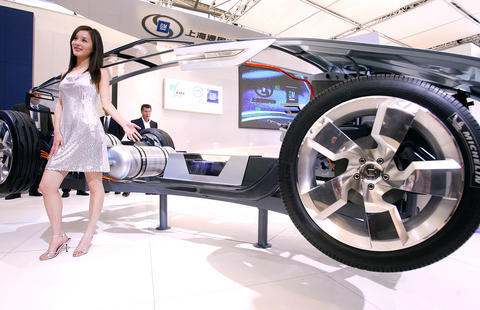Chinese automakers, under pressure from the government to produce more fuel-efficient cars, unveiled an unexpectedly broad array of prototypes for fuel-cell cars, gasoline-electric hybrid cars and electric-battery cars at the Shanghai auto show on Friday.
The variety and sophistication of the cars showed a striking improvement not just since the last Shanghai auto show two years ago, when Chinese automakers demonstrated scant technological innovation, but even in the months since the Beijing auto show last November.
Universities and technical institutes across China have started advanced vehicle propulsion research programs, combining strong government financial backing with China's rapidly growing ranks of skilled engineers.

PHOTO: AP
China, worried about severe air pollution and rising dependence on imported oil, has already imposed more stringent fuel economy standards than the US -- although not quite as stringent as the semi-voluntary standards that automakers have accepted in the EU.
China plans to tighten its standards considerably more next year. It has raised its consumption tax to as much as 20 percent on gas guzzlers, while cutting it to 1 percent for cars with small fuel-sipping engines. And China is studying whether to introduce tax incentives for buyers of hybrids.
Multinational automakers like General Motors and Volkswagen have begun cooperating closely with Chinese joint venture partners on the development of hybrid gasoline-electric vehicles. Larry Burns, GM's vice president for research and development, said the company was in talks with a Chinese joint venture partner on sharing hydrogen fuel-cell technology as well.
Xu Liuping (徐留平), the chief executive of Changan Automobile (長安汽車) in Chongqing, said the Chinese auto industry was working with the government to improve the country's energy security through more energy-efficient designs.
"The speed will be accelerated because available energy supplies are dwindling and because of the environmental protection aspect," Xu said in an interview at the Shanghai auto show.
Changan showed a hybrid gasoline-electric minivan here. Xu said that he had lined up local governments that promised to use it, making it possible for Changan to start manufacturing the vehicle next year.
Rick Wagoner, GM's chairman and chief executive, and Nick Reilly, the president of GM's Asian and Pacific regional operations, met on Thursday with senior Chinese officials in Beijing to discuss the company's energy efficiency plans, Reilly said. The Chinese government has not chosen among options like electric battery cars, fuel cells, hybrids and ethanol combustion, but wants the industry to move quickly to find the best approach and adopt it.
"It's absolutely at the top of the agenda" of the Chinese leadership, Reilly said.
Western environmentalists have long speculated whether China may actually leapfrog the West in personal transportation by embracing new automotive technologies before the country's oil and auto industries can become too wedded to internal combustion engines.
The odds of such a leapfrogging have eroded because nobody has yet surmounted the technological obstacles that prevent a broad switch from gasoline technology to hydrogen fuel cells, said An Feng, the executive director of the Innovation Center for Energy and Transportation in Beijing.
Shanghai Automotive Industry Corp (

Taiwan will prioritize the development of silicon photonics by taking advantage of its strength in the semiconductor industry to build another shield to protect the local economy, National Development Council (NDC) Minister Paul Liu (劉鏡清) said yesterday. Speaking at a meeting of the legislature’s Economics Committee, Liu said Taiwan already has the artificial intelligence (AI) industry as a shield, after the semiconductor industry, to safeguard the country, and is looking at new unique fields to build more economic shields. While Taiwan will further strengthen its existing shields, over the longer term, the country is determined to focus on such potential segments as

UNCERTAINTY: Innolux activated a stringent supply chain management mechanism, as it did during the COVID-19 pandemic, to ensure optimal inventory levels for customers Flat-panel display makers AUO Corp (友達) and Innolux Corp (群創) yesterday said that about 12 to 20 percent of their display business is at risk of potential US tariffs and that they would relocate production or shipment destinations to mitigate the levies’ effects. US tariffs would have a direct impact of US$200 million on AUO’s revenue, company chairman Paul Peng (彭雙浪) told reporters on the sidelines of the Touch Taiwan trade show in Taipei yesterday. That would make up about 12 percent of the company’s overall revenue. To cope with the tariff uncertainty, AUO plans to allocate its production to manufacturing facilities in

COLLABORATION: Given Taiwan’s key position in global supply chains, the US firm is discussing strategies with local partners and clients to deal with global uncertainties Advanced Micro Devices Inc (AMD) yesterday said it is meeting with local ecosystem partners, including Taiwan Semiconductor Manufacturing Co (TSMC, 台積電), to discuss strategies, including long-term manufacturing, to navigate uncertainties such as US tariffs, as Taiwan occupies an important position in global supply chains. AMD chief executive officer Lisa Su (蘇姿丰) told reporters that Taiwan is an important part of the chip designer’s ecosystem and she is discussing with partners and customers in Taiwan to forge strong collaborations on different areas during this critical period. AMD has just become the first artificial-intelligence (AI) server chip customer of TSMC to utilize its advanced

Chizuko Kimura has become the first female sushi chef in the world to win a Michelin star, fulfilling a promise she made to her dying husband to continue his legacy. The 54-year-old Japanese chef regained the Michelin star her late husband, Shunei Kimura, won three years ago for their Sushi Shunei restaurant in Paris. For Shunei Kimura, the star was a dream come true. However, the joy was short-lived. He died from cancer just three months later in June 2022. He was 65. The following year, the restaurant in the heart of Montmartre lost its star rating. Chizuko Kimura insisted that the new star is still down